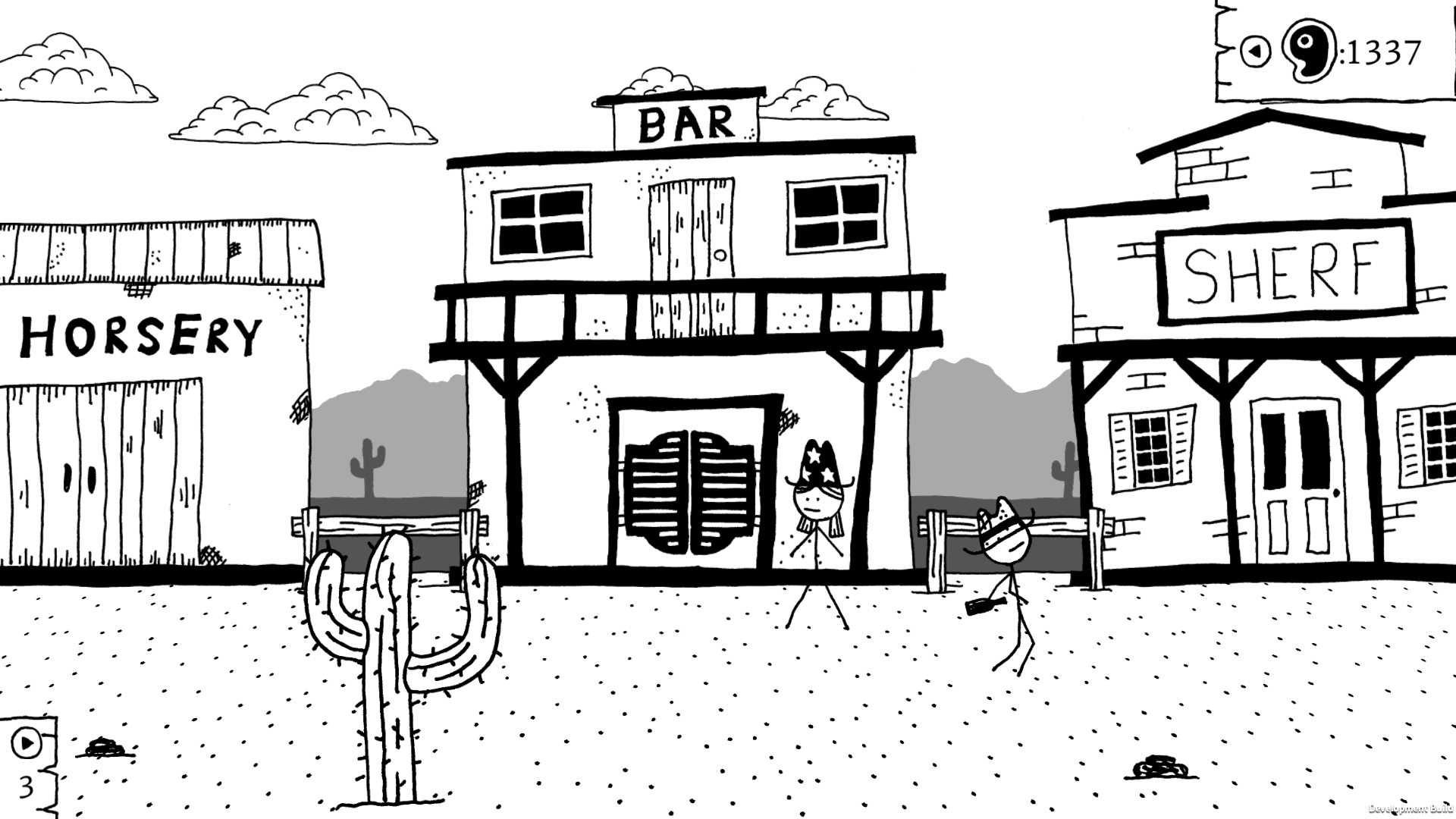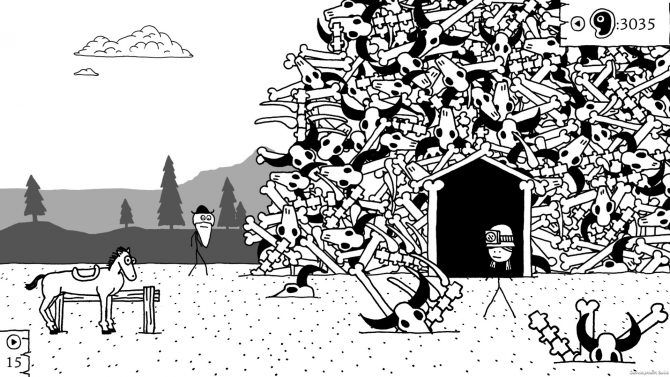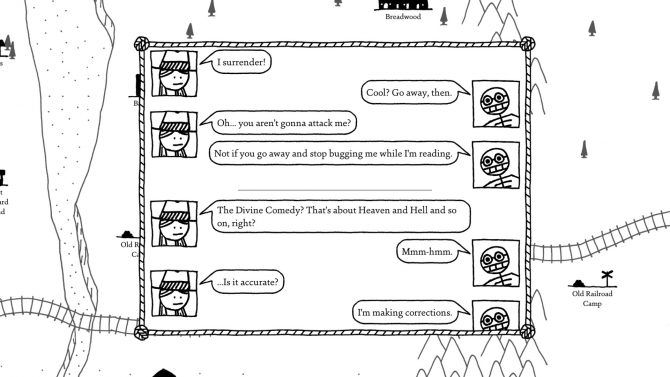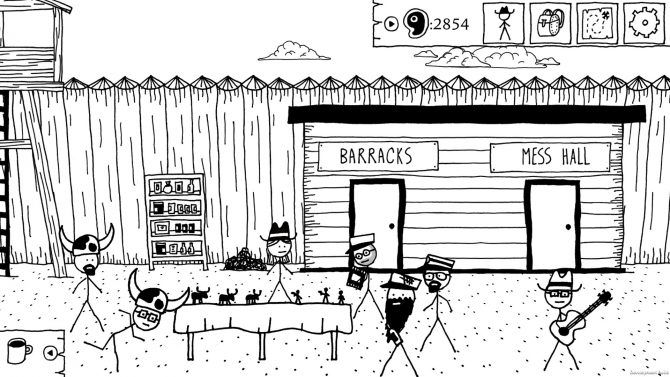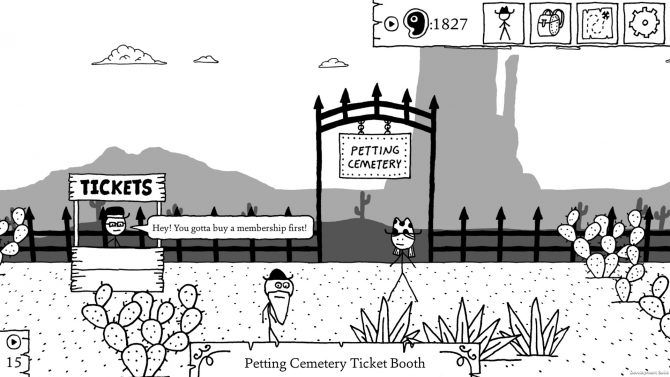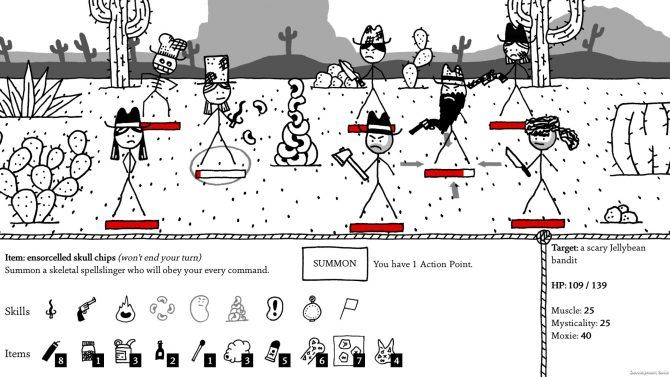Visuals can often be what stands out most about a game when playing. Of course, tight and solid gameplay is key to making a great title, but having distinct visuals does help nonetheless. I remember The Legend of Zelda: The Wind Waker's vibrant and beautiful cel-shaded art style just as much as I remember it's well-constructed sailing and action adventure gameplay. West of Loathing, developer Asymmetric's turn-based RPG successor to the popular 2003 title Kingdom of Loathing, features a wildly unique hand-drawn stick figure aesthetic that is still stuck in my mind long after finishing it.
While the game features one of the most memorable art styles I have seen from a game in recent years and contains well-written and quip-filled dialogue, West of Loathing does suffer from employing fairly basic and simple RPG mechanics despite doing something interesting with its character classes.
[pullquote]"The game features one of the most memorable art styles I have seen from a game in recent years and contains well-written and quip-filled dialogue."[/pullquote]
When you begin the game, players can choose to either be a stick figure boy or girl, and create your name through a random name generator. It tends to spit out very over the top cowboy sounding names like Cub Goldthwait and Grizzly Carson. It's then time to choose one of three classes: Cow Puncher, Bean Slinger, and Snake Oiler.
The Cow Puncher is closest to a typical warrior, and uses his strong fists and swords to take down his foes. The Bean Slinger acts like a mage, and can cook and use AP in battle cast spells spawned from magical beans. Finally, the Snake Oiler has an easier time crafting potions and has various serpent-oriented attacks, such as using a snake as a whip, or spawning it on their side of the field as an ally.
All three of these classes serve as a fun jab at typical RPG classes, even if the Cow Puncher and Bean Slinger fall into the typical cliches of the warrior and mage classes. If you want the most unique experience in West of Loathing I'd recommended the Snake Oiler, as it has the most unique abilities and can be really funny to watch in action sometimes.
After creating a character, the adventure begins as the player is going west to pursue their dreams, much to their family's discomfort. The first place players end up is Boring Springs, and aptly named small town where players can get used to the game's basic mechanics. It is also here in Boring Springs that the game's true charm starts to show. There are multiple dialogue options for most conversations, all of which are fleshed out, have different consequences, and are witty.
[pullquote]"Asymmetric didn't hold back with humor, stuffing as many jokes, puns, and quips in every facet of the game as possible."[/pullquote]
Asymmetric didn't hold back with humor, stuffing as many jokes, puns, and quips in every facet of the game as possible. Luckily, it rarely felt forced, as it played with a ton of cliches that are common within both RPGs and the Western genre. Players can also find books scattered across the environment that can give them new abilities, but some unlock new settings options for the game, such as Stupid Walking, which makes one's character walk around in as many different ways as his stick figure body structure allows.
That includes moving around by doing the worm, the Russian Gopak dance, and more. The game is fully self-aware at all times, and never really takes itself or its story about building a railroad to head even further westward as part of Manifest Destiny super seriously, allowing the humor to sink in. If you are looking for a serious Western story, look elsewhere, as West of Loathing is much closer to Blazing Saddles in tone than to Red Dead Redemption.
Outside the of its charming writing, the hand-drawn stick figure art style is what stands out to me most about West of Loathing. While it's predecessor Kingdom of Loathing was relegated to mostly text boxes and the occasional piece of art, West of Loathing was able to craft a fully realized world with black and white drawings and stick figures. While this artistic choice may sound limited at first, the developers really did all they could with this art style.
[pullquote]"West of Loathing looks like a childhood drawing that has come to life in the best way possible, and will likely be one of the most visually memorable titles that I play this year."[/pullquote]
There are tons of varied environments, from farms to mines, towns, and military forts. As shown with the aforementioned Stupid Walking setting, the developers also did a great job animating the simple stick figure characters. While the lack of color may make the game look a bit bland to some, its novelty and charm never wore off for me. West of Loathing looks like a childhood drawing that has come to life in the best way possible, and will likely be one of the most visually memorable titles that I play this year.
Unfortunately, the same can't always be said for the gameplay. Outside of battles, players can navigate their way through all of the game's different areas, either with point and click or traditional controls. Talking to NPC's activates quests learn about new areas to explore. Afterwards, one can hop on their horse and travel to new areas in an overworld map. While traveling, random event will pop up, which can instigate battles, help you learn new abilities, or get Meat, which functions as West of Loathing's currency.
Once players reach a certain area, they can explore and collect items scattered throughout the environment. Most items usually serve a purpose, whether it is to complete a quest or if it is just some type of armor or healing item. In these environments, players can run into a variety of enemies that manifest in a wide array of things, from typical bandits to flaming hell spawn cow-heads.
Battles play out in typical turn based fashion. Players have the ability to recruit a "pardner" (purposefully misspelled) early on, who can assist the player in battle with special abilities. Enemies can be attacked with an equipped sword or gun, or players can opt to use the special abilities that come with their class. Special attacks take up AP, or action points, which are limited for players each battle.
[pullquote]"Through both battles and random events, players can level up and build up their basic stats, combat skills, and perks, which creates a great feeling of progression as the players completes more and more quests and objectives."[/pullquote]
Both allies and enemies can occasional build cover to block their opponents from attacking. This adds some depth to battles, as one has to determine whether or not they want to waste an attack on a powerful blockade that an enemy is hiding behind, or if you want to attack an open enemy that may not pose as much of a threat. Through both battles and random events, players can level up and build up their basic stats, combat skills, and perks, which creates a great feeling of progression as the players completes more and more quests and objectives.
While this system is functional, albeit basic for the most part, AI problems and a lack of depth end up hurting the experience. In my time with the game, I found that the AI would tend to gang up on one character when attacking, regardless of what else may be occurring on the field at that time. This could make battles both ridiculously easy if they all decided to gang up to destroy cover instead of attacking an open character, or cheaply difficult if many powerful characters all decide to attack me at once.
I also saw the visuals glitch occasionally in battle, with health bars and cover not always syncing right with who they applied to. While West of Loathing's battle system never felt flat out broken, it is clearly the weak link of the game. While exploring the world and talking with characters never really got old, the battles did feel quite repetitive by the end of the game, and the occasional AI problems and visual glitches didn't help it.
[pullquote]"While I won't be forgetting this Western romp anytime soon, I'll be remembering the witty dialogue exchanges and unique graphics more than its gameplay."[/pullquote]
West of Loathing is one of the most memorable games I have played this year. It's unique simple-yet-detailed visuals and witty writing for everything from basic dialogue to item descriptions will keep fans of both westerns and RPGs very entertained. Unfortunately, once you hop into battle, the game's cracks start to show. While there is a great feeling of progression, West of Loathing's combat never did much to stand out from the systems in countless other turn-based RPGs. While I won't forget this Western romp anytime soon, I'll be remembering the witty dialogue exchanges and unique graphics more than its gameplay.

